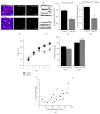Motor-Skill Learning Is Dependent on Astrocytic Activity
- PMID: 26346977
- PMCID: PMC4539503
- DOI: 10.1155/2015/938023
Motor-Skill Learning Is Dependent on Astrocytic Activity
Abstract
Motor-skill learning induces changes in synaptic structure and function in the primary motor cortex through the involvement of a long-term potentiation- (LTP-) like mechanism. Although there is evidence that calcium-dependent release of gliotransmitters by astrocytes plays an important role in synaptic transmission and plasticity, the role of astrocytes in motor-skill learning is not known. To test the hypothesis that astrocytic activity is necessary for motor-skill learning, we perturbed astrocytic function using pharmacological and genetic approaches. We find that perturbation of astrocytes either by selectively attenuating IP3R2 mediated astrocyte Ca(2+) signaling or using an astrocyte specific metabolic inhibitor fluorocitrate (FC) results in impaired motor-skill learning of a forelimb reaching-task in mice. Moreover, the learning impairment caused by blocking astrocytic activity using FC was rescued by administration of the gliotransmitter D-serine. The learning impairments are likely caused by impaired LTP as FC blocked LTP in slices and prevented motor-skill training-induced increases in synaptic AMPA-type glutamate receptor in vivo. These results support the conclusion that normal astrocytic Ca(2+) signaling during a reaching task is necessary for motor-skill learning.
Figures




Similar articles
-
l-α-aminoadipate causes astrocyte pathology with negative impact on mouse hippocampal synaptic plasticity and memory.FASEB J. 2021 Aug;35(8):e21726. doi: 10.1096/fj.202100336R. FASEB J. 2021. PMID: 34196433
-
Altered structural and functional synaptic plasticity with motor skill learning in a mouse model of fragile X syndrome.J Neurosci. 2013 Dec 11;33(50):19715-23. doi: 10.1523/JNEUROSCI.2514-13.2013. J Neurosci. 2013. PMID: 24336735 Free PMC article.
-
Dopamine Promotes Motor Cortex Plasticity and Motor Skill Learning via PLC Activation.PLoS One. 2015 May 4;10(5):e0124986. doi: 10.1371/journal.pone.0124986. eCollection 2015. PLoS One. 2015. PMID: 25938462 Free PMC article.
-
The IP3R2 Knockout Mice in Behavior: A Blessing or a Curse?J Neurochem. 2025 Apr;169(4):e70062. doi: 10.1111/jnc.70062. J Neurochem. 2025. PMID: 40172184 Review.
-
An active role for astrocytes in synaptic plasticity?J Neurophysiol. 2010 Sep;104(3):1216-8. doi: 10.1152/jn.00429.2010. Epub 2010 Jul 7. J Neurophysiol. 2010. PMID: 20610782 Review.
Cited by
-
Astrocyte metabolism and signaling pathways in the CNS.Front Neurosci. 2023 Sep 4;17:1217451. doi: 10.3389/fnins.2023.1217451. eCollection 2023. Front Neurosci. 2023. PMID: 37732313 Free PMC article. Review.
-
Mathematical Modeling in Neuroscience: Neuronal Activity and Its Modulation by Astrocytes.Front Integr Neurosci. 2016 Feb 4;10:3. doi: 10.3389/fnint.2016.00003. eCollection 2016. Front Integr Neurosci. 2016. PMID: 26869893 Free PMC article. No abstract available.
-
Astrocytes and Behavior.Annu Rev Neurosci. 2021 Jul 8;44:49-67. doi: 10.1146/annurev-neuro-101920-112225. Epub 2021 Jan 6. Annu Rev Neurosci. 2021. PMID: 33406370 Free PMC article.
-
Modeling Neurodevelopmental and Neuropsychiatric Diseases with Astrocytes Derived from Human-Induced Pluripotent Stem Cells.Int J Mol Sci. 2021 Feb 8;22(4):1692. doi: 10.3390/ijms22041692. Int J Mol Sci. 2021. PMID: 33567562 Free PMC article. Review.
-
IP3R2-Mediated Astrocytic Ca2+ Transients Are Critical to Sustain Modulatory Effects of Locomotion on Neurons in Mouse Somatosensory Cortex.Cells. 2025 Jul 18;14(14):1103. doi: 10.3390/cells14141103. Cells. 2025. PMID: 40710356 Free PMC article.
References
Publication types
MeSH terms
Substances
Grants and funding
LinkOut - more resources
Full Text Sources
Other Literature Sources
Miscellaneous

